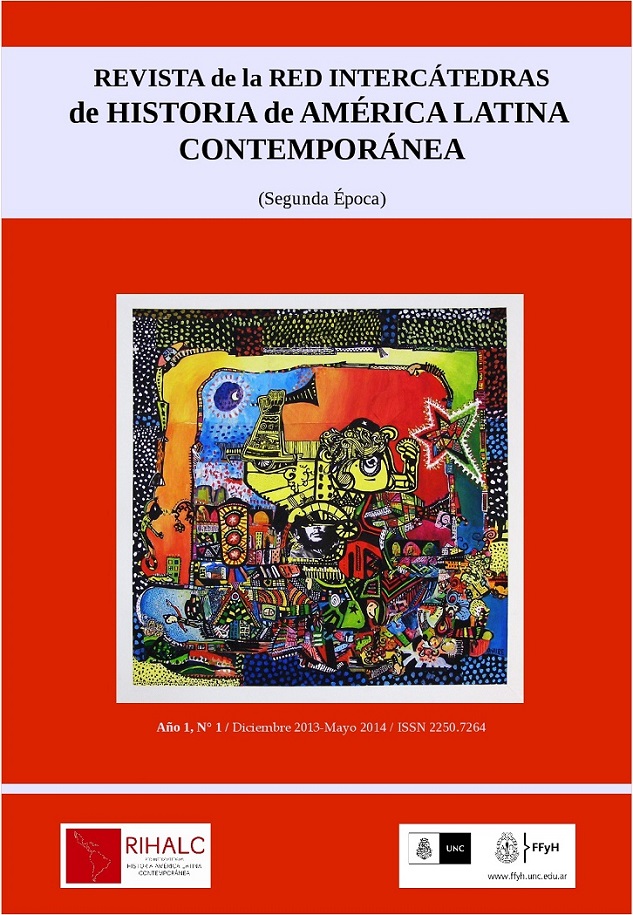Populism revisited: notes to unveil its analysis.
Keywords:
Populismo, Estado, Sociedad, Movilización, participación políticaAbstract
This paper intended as a series of "notes Professor", intended to constitute a look at the phenomenon of populism. The goal is more like what the French call a pris of position: articulate a perspective to discuss it and explore it later. In this analysis, we understand populism as historical forms assumed the state and governance of a democratic type, was one of the possibilities that made their way in a particular context, with the help of a novel relationship between State and Society. The emergence of Latin American populism can be analyzed as the search for a solution to the crisis of hegemony lived in the thirties, linked to a specific context of peripheral capitalism (dependent) and a particular social structure transformation, urban growth and the emergence of the masses in the public arena. By "mass" refers to social groups excluded from effective political participation-elect and be elected. In this sense, there are objective conditions concerning the context of Latin America between 1920 and 1930 that explain the emergence and development of populism, these conditions generate a particular dynamic between social actors, defined from the relationship between the emergence of the "masses "in the political arena, their mobilization in search of a radical-and populist regime. The ambiguity of these populist particularly as intrinsic to its dynamic feature, helps to explain not only the origin and development but also the dismantling.
Downloads
References
Álvarez Juncos, José y González Leandri, Ricardo (compiladores) (1994): El populismo en España y América, Editorial Catriel, Madrid.
Ansaldi, Waldo (Editor) (2003): Tierra en llamas. América Latina en los años 1930, Ediciones Al Margen, La Plata, 2ª edición (corregida y ampliada).
____ (1992/1): “Frívola y casquivana, mano de hierro en guante de seda. Una propuesta para conceptualizar el término oligarquía en América Latina”. En revista Cuadernos del Claeh, Año 17, Nº 61, Montevideo, pp. 43-48.
Ansaldi, Waldo; Giordano, Verónica (2012): América latina: la construcción del orden, Ariel, Buenos Airess, Tomos I y II.
Ansaldi, Waldo; Funes Patricia (1998): “Viviendo una hora latinoamericana. Acerca de rupturas y continuidades en el pensamiento en los años veinte y sesenta”, en Cuadernos del CISH, Nº 5, La Plata, pp. 13 – 75.
Arditi, Benjamín (2004): “El populismo como espectro de la democracia: una respuesta a Canovan”. En Revista Mexicana de Ciencias políticas y Sociales, vol XLVII, Nº 191, mayo – agosto, pp 86-99.
Bethell, Leslie (Ed.) (1985): Historia de América Latina, Editorial Crítica, Barcelona, 1991-2002, tomos 5 a 16. [Se trata de la versión en español de The Cambridge History of Latin America, Cambridge University Press, 1985].
Bloch, Marc (1952): Introducción a la Historia, Fondo de Cultura económica, México.
Fausto, Boris., Historia concisa de Brasil, EDUSP, San Pablo.
Mackinnon, María y Petrone, Mario (compiladores) (1998): Populismo y neopopulismo en América Latina. El problema de la Cenicienta, EUDEBA, Buenos Aires.
Petrone, Mario (2003): “La década del treinta en México”, en Tierra en llamas. América Latina en los años 1930, Ediciones Al Margen, La Plata, 2ª edición (corregida y ampliada), pp253-273
Knight, Alan (1998a): “México, c.1930-1946”, en Bethell Leslie (ED.) Historia de América Latina, Tomo 13, Crítica, Barcelona, pp 157- 183.
Vilas, Carlos (comp.) (1995): La democratización fundamental. El populismo en América Latina, Consejo Nacional para la Cultura y las Artes, México DF.
Weffort, Francisco (1968a): “Clases populares y desarrollo social (Contribución al estudio del Populismo)”, en Revista Paraguaya de Sociología, Centro Paraguayo de Estudios Sociológicos, año 5, Nº 13, pp 35-52.
Downloads
Published
How to Cite
Issue
Section
License
Aquellos autores/as que tengan publicaciones con esta revista, aceptan los términos siguientes:
- Los autores/as conservarán sus derechos de autor y garantizarán a la revista el derecho de primera publicación de su obra, el cuál estará simultáneamente sujeto a la Licencia de reconocimiento de Creative Commons que permite la libre distribución con mención de su(s) creadores, no permite el uso comercial ni las obras derivadas. Los autores, al enviar el artículo, acuerdan publicarlo bajo esta licencia..
- Los autores/as podrán adoptar otros acuerdos de licencia no exclusiva de distribución de la versión de la obra publicada (p. ej.: depositarla en un archivo telemático institucional o publicarla en un volumen monográfico) siempre que se indique la publicación inicial en esta revista.
- Se permite y recomienda a los autores/as difundir su obra a través de Internet (p. ej.: en archivos telemáticos institucionales o en su página web) después del proceso de publicación.



